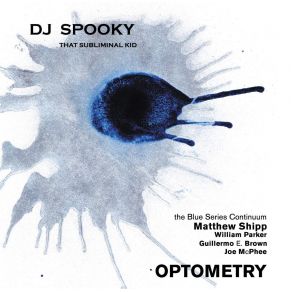Optometry
Download links and information about Optometry by Dj Spooky. This album was released in 2002 and it belongs to Electronica, Jazz, Dancefloor, Dance Pop genres. It contains 13 tracks with total duration of 01:13:55 minutes.

|
|
|---|---|
| Artist: | Dj Spooky |
| Release date: | 2002 |
| Genre: | Electronica, Jazz, Dancefloor, Dance Pop |
| Tracks: | 13 |
| Duration: | 01:13:55 |
| Buy it NOW at: | |
| Buy on iTunes $9.99 | |
| Buy on Amazon $8.99 | |
| Buy on Songswave €2.08 | |
Tracks
[Edit]| No. | Title | Length |
|---|---|---|
| 1. | Ibid, Desmarches, Ibid | 5:40 |
| 2. | Reactive Switching Strategies for the Control of Uninhabited Air | 6:14 |
| 3. | Variation Cybernetique - Rhythmic Pataphysic, Pt. 1 | 2:48 |
| 4. | Asphalt (Tome 2) | 7:03 |
| 5. | Optometry | 11:36 |
| 6. | Sequentia Absentia (Dialectical Triangulation, Pt. 1) | 7:03 |
| 7. | Rosemary | 4:10 |
| 8. | Dementia Absentia (Dialectical Triangulation, Pt. 2) | 3:34 |
| 9. | Parachutes | 5:26 |
| 10. | Absentia Absentia (Dialectical Triangulation, Pt. 3) | 3:51 |
| 11. | Variation Cybernetique: Rhythmic Pataphysic (Pt. 2) | 2:12 |
| 12. | Periphique | 9:07 |
| 13. | It's a Mad, Mad, Mad, World | 5:11 |
Details
[Edit]Thirsty Ear's Blue Series has already been host to many progressive jazz projects, among them albums by William Parker, Matthew Shipp, Craig Taborn, Guillermo Brown, Mat Maneri, Tim Berne, and others. The label also did a project with British DJ drum'n'bass duo Spring Heel Jack that was neither a jazz album or a DJ record, but some strange amalgam unto itself. DJ Spooky's Optometry is the next installment in the Blue Series' DJ experiments, and it's one that succeeds on every level. For starters, Optometry is fully a DJ outing and fully a jazz record. The band playing with Spooky is comprised of Parker; Shipp; Brown; Medeski , Martin & Wood's Billy Martin; Joe McPhee; Carl Hancock Rux; and others. Spooky plays bass and kalimba besides his turntables and mixing board. He illustrates, collages, paints, spindles, cuts, and mixes a live performance by the rest of the band. On "Reactive Switching Strategies for the Control of Uninhabited Air," Billy Martin cascades snares and toms in counterpoint to his ride cymbal, setting up a rhythm that is followed by Parker and Shipp. Shipp's playing fleshes out the motif and makes it a modal stretch, and the time signatures fluctuate between four and eight, as Spooky dovetails — à la Brian Eno — various timbres and harmonics emitted by the individual musicians, as well as the quartet sound. Slipping keyboard washes in between Shipp's repetitive lines that are big enough for Parker to vamp crazily on, and putting distance in between various segments is the DJ's art here. The title track moves from abstract arpeggiattic saxophone striations by McPhee to phat, dirty, nasty, synth lines from Shipp, playing some combination of the funk in Sun Ra's Lanquidity and Herbie Hancock's Head Hunters. While this is happening, Parker pops and bows his bass to stay alongside the bottom end of the groove for a particularly disorienting effect, as it almost falls apart at the beginning of each chorus. Spooky samples all the proceedings and mirrors them back slightly altered while adding loops and found sounds to break down even the most innate structure in the tune so it has to be built according to memory. Whew! When the scratch attempts to do that, Shipp moves to his acoustic piano, and McPhee comes inside to refract Shipp's lines back to the rhythm section — which includes Spooky at this point. And this goes on for almost 12 minutes. There is no let up in the creative vibe here; each member attempts to express for the collective. Spooky included. Riff, vamp, timbral fractures, lyrical tension, splintered harmonics, and a constant, seductive sense of groove permeate this jazz album, opening up a door onto a brave new future for a free jazz with soul — Spooky has exceeded all expectations here.